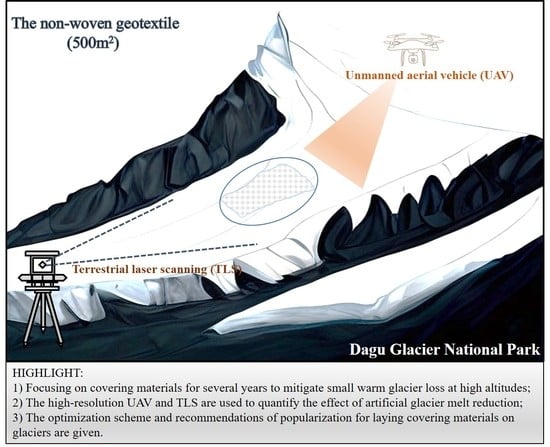Applying Artificial Cover to Reduce Melting in Dagu Glacier in the Eastern Qinghai-Tibetan Plateau
Abstract
:1. Introduction
2. Study Site
3. Materials
4. Methods
4.1. Glaciological Method
4.2. Terrestrial Laser Scanning
4.2.1. Riegl VZ®-6000 Terrestrial Laser Scanner
4.2.2. Point Cloud Data Acquisition and Processing
- (1)
- Direct georeferencing. The method uses a total station to transform the laser scanner system [25]. The coordinates of the scanning system are transformed from the local coordinate system to the global coordinate system using RTK measurements from various scanning stations.
- (2)
- Point cloud vacuation and filtering. An octree algorithm was applied to the registered scans to generate points with equal spacing to realize point cloud data reduction [27], and a terrain filter was used to remove noise and non-ground points.
- (3)
- Point cloud registration was performed based on the Iterative Closest Point (ICP) algorithm. Based on minimizing the least squares of residuals, the direction of each scan was iteratively adjusted, and the optimal fitting between the point clouds was calculated [29]. The specific processing flow is shown in Figure 3.
4.3. Unmanned Aerial Vehicle Surveys
4.3.1. DJI Phantom 4 RTK
4.3.2. UAV Data Acquisition and Processing
- (1)
- Initial processing: This process uses the structure-from-motion algorithm to generate a sparse point cloud [33]. Firstly, a feature matching algorithm (such as scale-invariant feature transform (SIFT), which can detect key points in photos under different viewing angles and lighting conditions) is used. Secondly, the rough position and orientation of the camera at each exposure station is reconstructed using internal parameters (focal length, photo principal point coordinates) and external parameters (i.e., POS data). A sparse point cloud is created.
- (2)
- Point cloud densification: In this step, multi-view stereo techniques are applied to obtain a higher point cloud density than in the previous step [34]. Therefore, the spatial resolution of the product can be enhanced, and an irregular network can be created for the next step.
- (3)
- Digital elevation model (DEM) and orthomosaic generation: DEM and orthomosaic are the two main final products. DEM can be constructed using a dense point cloud and an irregular network, with high accuracy for rugged terrain. Each image pixel is projected onto the DEM to generate a geo-referenced orthomosaic [35]. Since P4RTK is equipped with RTK, no GCP has to be installed for the geo-correction of the photogrammetric point cloud, and only checkpoints have to be established to evaluate the accuracy of the derived DEMs with 5 checkpoints for the first flight and 6 checkpoints for the second (Figure 4).
4.4. Uncertainty Assessment
4.4.1. Uncertainties of Glaciological Measurements
4.4.2. Uncertainties of Geodetic Mass Balance
- (1)
- UAV uncertainty assessment
- (2)
- TLS uncertainty assessment
5. Results
6. Discussion
6.1. Accuracy in Glaciological Measurement
6.2. The Effects of the Geotextiles
6.3. Comparison of Similar Experiments
6.4. Feasibility Analysis
7. Conclusions
Author Contributions
Funding
Data Availability Statement
Conflicts of Interest
References
- Su, B.; Xiao, C.; Chen, D.; Huang, Y.; Che, Y.; Zhao, H.; Zou, M.; Guo, R.; Wang, X.; Li, X. Glacier change in China over past decades: Spatiotemporal patterns and influencing factors. Earth Sci. Rev. 2022, 226, 103926. [Google Scholar] [CrossRef]
- Azam, M.F.; Kargel, J.S.; Shea, J.M.; Nepal, S.; Haritashya, U.K.; Srivastava, S.; Maussion, F.; Qazi, N.; Chevallier, P.; Dimri, A.P.; et al. Glaciohydrology of the Himalaya-Karakoram. Science 2021, 373, eabf3668. [Google Scholar] [CrossRef] [PubMed]
- Syvitski, J.; Ángel, J.R.; Saito, Y.; Overeem, I.; Vörösmarty, C.J.; Wang, H.; Olago, D. Earth’s sediment cycle during the Anthropocene. Nat. Rev. Earth. Environ. 2022, 3, 179–196. [Google Scholar] [CrossRef]
- Zemp, M.; Huss, M.; Thibert, E.; Eckert, N.; McNabb, R.; Huber, J.; Barandun, M.; Machguth, H.; Nussbaumer, S.U.; Gärtner-Roer, I. Global glacier mass changes and their contributions to sea-level rise from 1961 to 2016. Nature 2019, 568, 382–386. [Google Scholar] [CrossRef] [Green Version]
- Shen, C.; Jia, L.; Ren, S. Inter- and Intra-Annual Glacier Elevation Change in High Mountain Asia Region Based on ICESat-1&2 Data Using Elevation-Aspect Bin Analysis Method. Remote Sens. 2022, 14, 1630. [Google Scholar] [CrossRef]
- Wu, K.; Liu, S.; Zhu, Y.; Xie, F.; Gao, Y.; Qi, M.; Miao, W.; Duan, S.; Han, F.; Grunwald, R. Monitoring the Surface Elevation Changes of a Monsoon Temperate Glacier with Repeated UAV Surveys, Mainri Mountains, China. Remote Sens. 2022, 14, 2229. [Google Scholar] [CrossRef]
- Liu, L.; Jiang, L.; Jiang, H.; Wang, H.; Ma, N.; Xu, H. Accelerated glacier mass loss (2011–2016) over the Puruogangri ice field in the inner Tibetan Plateau revealed by bistatic InSAR measurements. Remote Sens. Environ. 2019, 231, 111241. [Google Scholar] [CrossRef]
- Bolibar, J.; Rabatel, A.; Gouttevin, I.; Zekollari, H.; Galiez, C. Nonlinear sensitivity of glacier mass balance to future climate change unveiled by deep learning. Nat. Commun. 2022, 13, 409. [Google Scholar] [CrossRef]
- Bosson, J.-B.; Huss, M.; Osipova, E. Disappearing World Heritage Glaciers as a Keystone of Nature Conservation in a Changing Climate. Earth’s Future 2019, 7, 469–479. [Google Scholar] [CrossRef] [Green Version]
- Marzeion, B.; Champollion, N.; Haeberli, W.; Langley, K.; Leclercq, P.; Paul, F. Observation-Based Estimates of Global Glacier Mass Change and Its Contribution to Sea-Level Change. Surv. Geophys. 2017, 38, 105–130. [Google Scholar] [CrossRef] [Green Version]
- Huss, M.; Schwyn, U.; Bauder, A.; Farinotti, D. Quantifying the overall effect of artificial glacier melt reduction in Switzerland, 2005–2019. Cold Reg. Sci. Technol. 2021, 184, 103237. [Google Scholar] [CrossRef]
- Fischer, A.; Helfricht, K.; Stocker-Waldhuber, M. Local reduction of decadal glacier thickness loss through mass balance management in ski resorts. Cryosphere 2016, 10, 2941–2952. [Google Scholar] [CrossRef] [Green Version]
- Grünewald, T.; Wolfsperger, F.; Lehning, M. Snow farming: Conserving snow over the summer season. Cryosphere 2018, 12, 385–400. [Google Scholar] [CrossRef] [Green Version]
- Olefs, M.; Fischer, A. Comparative study of technical measures to reduce snow and ice ablation in Alpine glacier ski resorts. Cold Reg. Sci. Technol. 2008, 52, 371–384. [Google Scholar] [CrossRef]
- Senese, A.; Azzoni, R.S.; Maragno, D.; D’Agata, C.; Fugazza, D.; Mosconi, B.; Trenti, A.; Meraldi, E.; Smiraglia, C.; Diolaiuti, G. The non-woven geotextiles as strategies for mitigating the impacts of climate change on glaciers. Cold Reg. Sci. Technol. 2020, 173, 103007. [Google Scholar] [CrossRef]
- Olefs, M.; Lehning, M. Textile protection of snow and ice: Measured and simulated effects on the energy and mass balance. Cold Reg. Sci. Technol. 2010, 62, 126–141. [Google Scholar] [CrossRef]
- Wang, F.; Yue, X.; Wang, L.; Li, H.; Du, Z.; Ming, J.; Li, Z. Applying artificial snowfall to reduce the melting of the Muz Taw Glacier, Sawir Mountains. Cryosphere 2020, 14, 2597–2606. [Google Scholar] [CrossRef]
- Geissler, J.; Mayer, C.; Jubanski, J.; Münzer, U.; Siegert, F. Analyzing glacier retreat and mass balances using aerial and UAV photogrammetry in the Ötztal Alps, Austria. Cryosphere 2021, 15, 3699–3717. [Google Scholar] [CrossRef]
- Goerlich, F.; Bolch, T.; Paul, F. More dynamic than expected: An updated survey of surging glaciers in the Pamir. Earth Syst. Sci. Data 2020, 12, 3161–3176. [Google Scholar] [CrossRef]
- Stumm, D.; Joshi, S.P.; Gurung, T.R.; Silwal, G. Mass balances of Yala and Rikha Samba glaciers, Nepal, from 2000 to 2017. Earth Syst. Sci. Data 2021, 13, 3791–3818. [Google Scholar] [CrossRef]
- Wei, Y.; Wang, S.; Liu, J.; Zhou, L. Multi-Source Remote-Sensing Monitoring of the Monsoonal Maritime Glaciers at Mt. Dagu, East Qinghai-Tibetan Plateau, China. IEEE Access 2019, 7, 48307–48317. [Google Scholar] [CrossRef]
- Wang, S.J.; Zhou, L.Y. Integrated impacts of climate change on glacier tourism. Adv. Clim. Chang. Res. 2019, 10, 71–79. [Google Scholar] [CrossRef]
- Wang, X.; Qin, D.-H.; Ren, J.-W.; Wang, F.-T. Numerical estimation of thermal insulation performance of different coverage schemes at three places for snow storage. Adv. Clim. Chang. Res. 2021, 12, 903–912. [Google Scholar] [CrossRef]
- Palmeira, E.M.; Gardoni, M.G. Drainage and filtration properties of non-woven geotextiles under confinement using different experimental techniques. Geotext Geomembranes 2002, 20, 97–115. [Google Scholar] [CrossRef]
- Wang, P.; Li, Z.; Li, H.; Wang, W.; Zhou, P.; Wang, L. Characteristics of a partially debris-covered glacier and its response to atmospheric warming in Mt. Tomor, Tien Shan, China. Glob. Planet Chang. 2017, 159, 11–24. [Google Scholar] [CrossRef]
- Mukupa, W.; Roberts, G.W.; Hancock, C.M.; Al-Manasir, K. A review of the use of terrestrial laser scanning application for change detection and deformation monitoring of structures. Survey Rev. 2017, 49, 99–116. [Google Scholar] [CrossRef]
- Xu, C.; Li, Z.; Wang, F.; Li, H.; Wang, W.; Wang, L.I.N. Using an ultra-long-range terrestrial laser scanner to monitor the net mass balance of Urumqi Glacier No. 1, eastern Tien Shan, China, at the monthly scale. J. Glaciol. 2017, 63, 792–802. [Google Scholar] [CrossRef]
- Fischer, M.; Huss, M.; Kummert, M.; Hoelzle, M. Application and validation of long-range terrestrial laser scanning to monitor the mass balance of very small glaciers in the Swiss Alps. Cryosphere 2016, 10, 1279–1295. [Google Scholar] [CrossRef] [Green Version]
- Prantl, H.; Nicholson, L.; Sailer, R.; Hanzer, F.; Juen, I.F.; Rastner, P. Glacier Snowline Determination from Terrestrial Laser Scanning Intensity Data. Geosciences 2017, 7, 60. [Google Scholar] [CrossRef] [Green Version]
- Stott, E.; Williams, R.; Hoey, T. Ground Control Point Distribution for Accurate Kilometre-Scale Topographic Mapping Using an RTK-GNSS Unmanned Aerial Vehicle and SfM Photogrammetry. Drones 2020, 4, 55. [Google Scholar] [CrossRef]
- Wigmore, O.; Mark, B. Monitoring tropical debris-covered glacier dynamics from high-resolution unmanned aerial vehicle photogrammetry, Cordillera Blanca, Peru. Cryosphere 2017, 11, 2463–2480. [Google Scholar] [CrossRef] [Green Version]
- Revuelto, J.; López-Moreno, J.I.; Alonso-González, E. Light and Shadow in Mapping Alpine Snowpack With Unmanned Aerial Vehicles in the Absence of Ground Control Points. Water Resour. Res. 2021, 57, e2020WR028980. [Google Scholar] [CrossRef]
- Turner, D.; Lucieer, A.; Watson, C. An Automated Technique for Generating Georectified Mosaics from Ultra-High Resolution Unmanned Aerial Vehicle (UAV) Imagery, Based on Structure from Motion (SfM) Point Clouds. Remote Sens. 2012, 4, 1392–1410. [Google Scholar] [CrossRef] [Green Version]
- Mölg, N.; Bolch, T. Structure-from-Motion Using Historical Aerial Images to Analyse Changes in Glacier Surface Elevation. Remote Sens. 2017, 9, 1021. [Google Scholar] [CrossRef] [Green Version]
- Xue, Y.; Jing, Z.; Kang, S.; Xiaobo, H.; Li, C. Combining UAV and Landsat data to assess glacier changes on the central Tibetan Plateau. J. Glaciol. 2021, 67, 1–13. [Google Scholar] [CrossRef]
- Zemp, M.; Thibert, E.; Huss, M.; Stumm, D.; Denby, C.; Nuth, C.; Nussbaumer, S.; Moholdt, G.; Mercer, A.; Mayer, C. Uncertainties and re-analysis of glacier mass balance measurements. Cryosphere 2013, 7, 789–839. [Google Scholar] [CrossRef] [Green Version]
- Xu, C.; Li, Z.; Li, H.; Wang, F.; Zhou, P. Long-range terrestrial laser scanning measurements of annual and intra-annual mass balances for Urumqi Glacier No. 1, eastern Tien Shan, China. Cryosphere 2019, 13, 2361–2383. [Google Scholar] [CrossRef] [Green Version]
- Huss, M.; Bauder, A.; Funk, M. Homogenization of long-term mass-balance time series. Ann. Glaciol. 2009, 50, 198–206. [Google Scholar] [CrossRef] [Green Version]
- Zemp, M.; Jansson, P.; Holmlund, P.; Gärtner-Roer, I.; Koblet, T.; Thee, P.; Haeberli, W. Reanalysis of multi-temporal aerial images of Storglaciären, Sweden (1959–99)—Part 2: Comparison of glaciological and volumetric mass balances. Cryosphere 2010, 4, 345–357. [Google Scholar] [CrossRef] [Green Version]
- Thibert, E.; Blanc, R.; Vincent, C.; Eckert, N. Glaciological and volumetric mass-balance measurements: Error analysis over 51 years for Glacier de Sarennes, French Alps. J. Glaciol. 2008, 54, 522–532. [Google Scholar] [CrossRef] [Green Version]
- Lamsters, K.; Jeskins, J.; Sobota, I.; Karuss, J.; Dzerins, P. Surface Characteristics, Elevation Change, and Velocity of High-Arctic Valley Glacier from Repeated High-Resolution UAV Photogrammetry. Remote Sens. 2022, 14, 1029. [Google Scholar] [CrossRef]
- De Gaetani, C.I.; Ioli, F.; Pinto, L. Aerial and UAV Images for Photogrammetric Analysis of Belvedere Glacier Evolution in the Period 1977–2019. Remote Sens. 2021, 13, 3787. [Google Scholar] [CrossRef]
- Dumont, M.; Gardelle, J.; Sirguey, P.; Guillot, A.; Six, D.; Rabatel, A.; Arnaud, Y. Linking glacier annual mass balance and glacier albedo retrieved from MODIS data. Cryosphere 2012, 6, 1527–1539. [Google Scholar] [CrossRef] [Green Version]
- Naegeli, K.; Huss, M. Sensitivity of mountain glacier mass balance to changes in bare-ice albedo. Ann. Glaciol. 2017, 58, 119–129. [Google Scholar] [CrossRef] [Green Version]
- Nestler, A.; Huss, M.; Ambartzumian, R.; Hambarian, A. Hydrological Implications of Covering Wind-Blown Snow Accumulations with Geotextiles on Mount Aragats, Armenia. Geosciences 2014, 4, 73–92. [Google Scholar] [CrossRef] [Green Version]

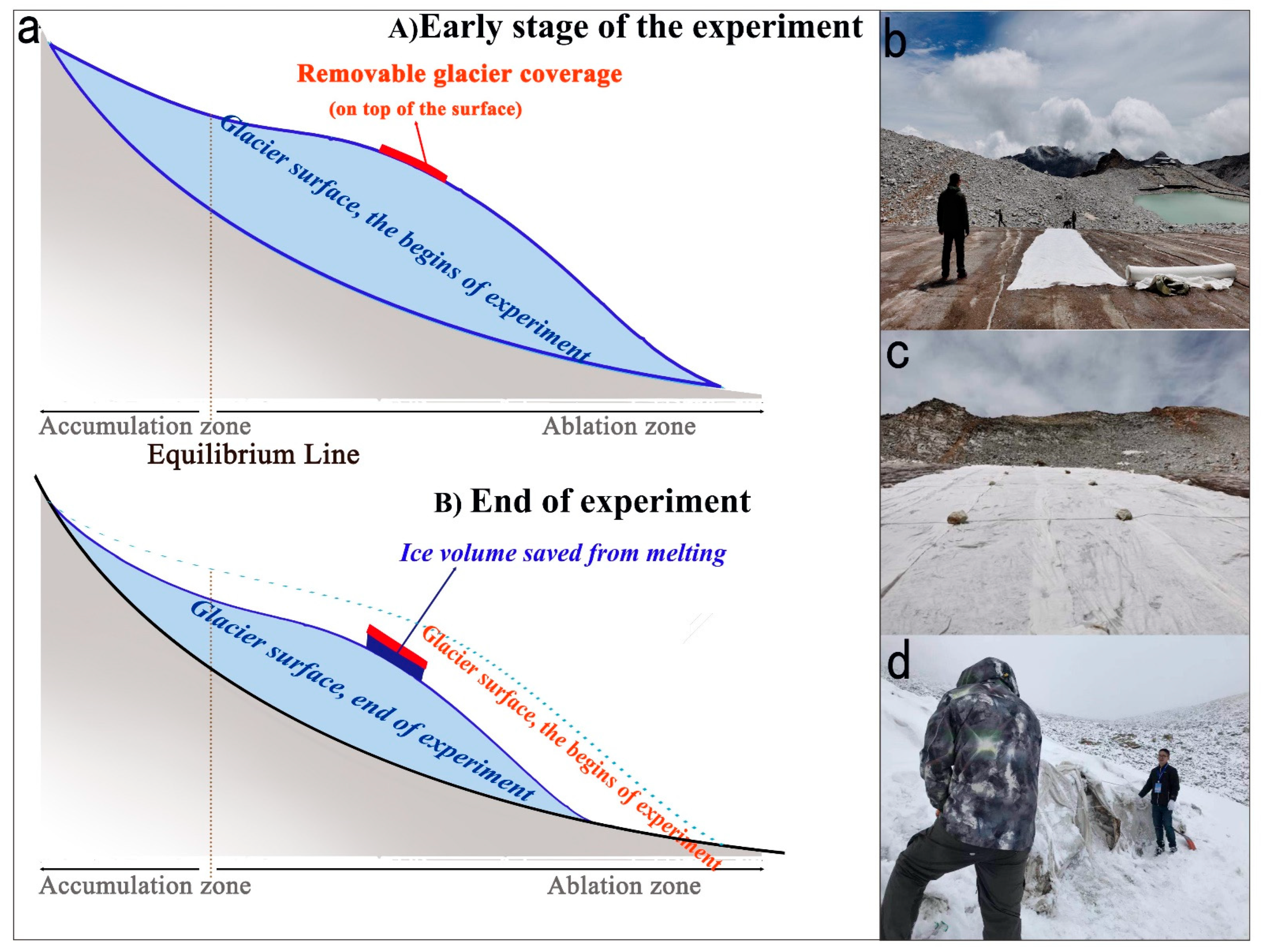
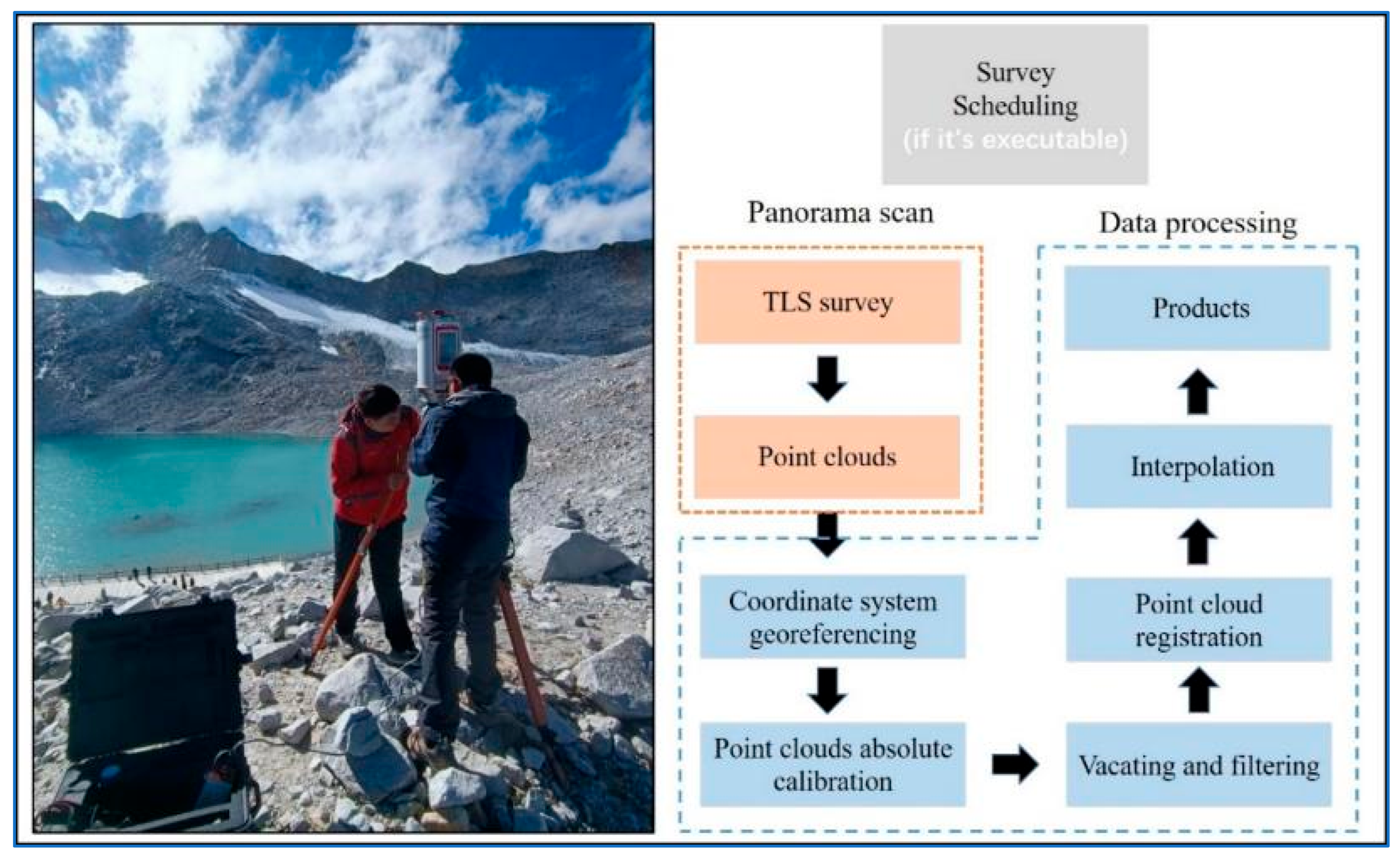
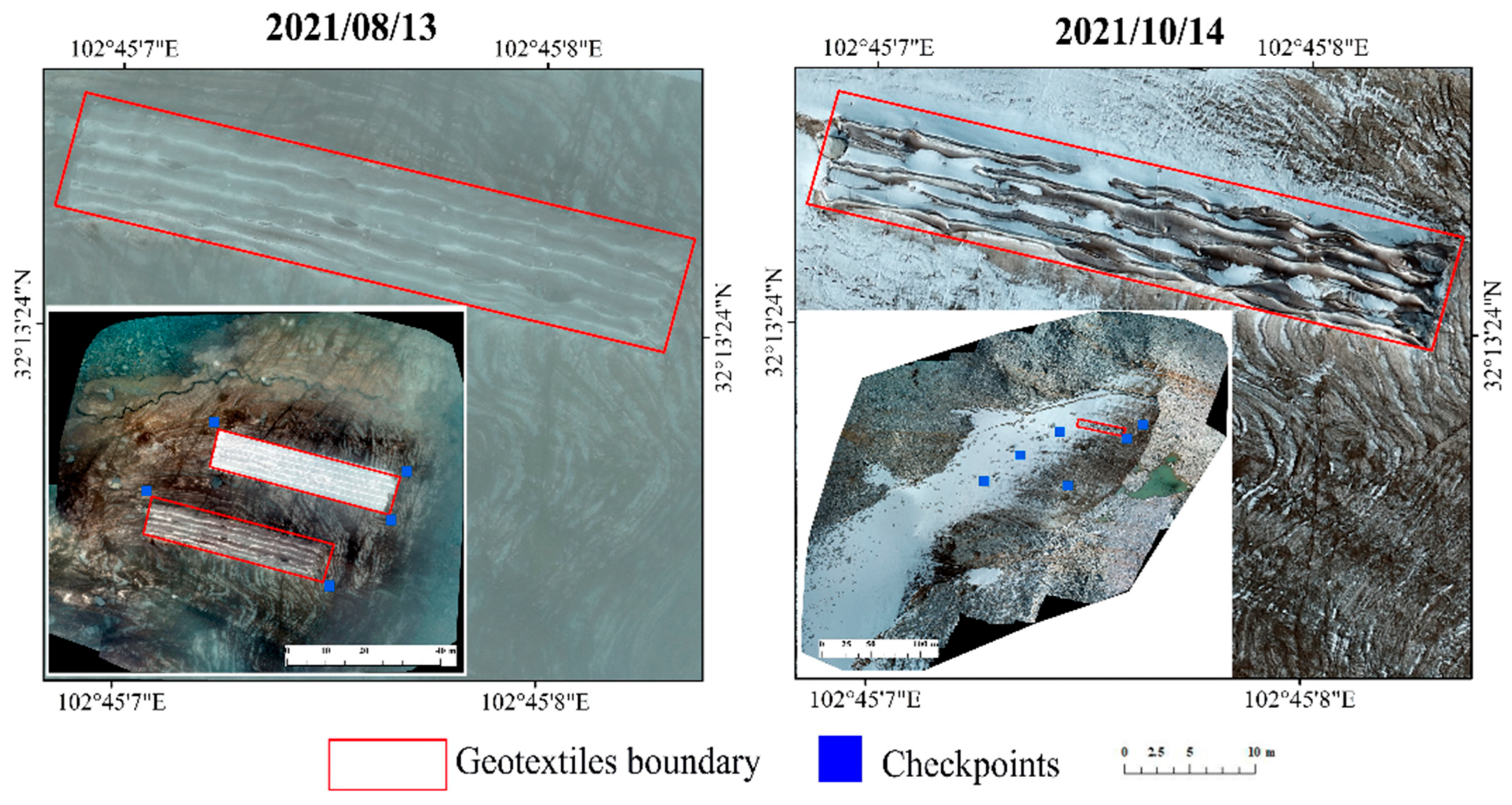
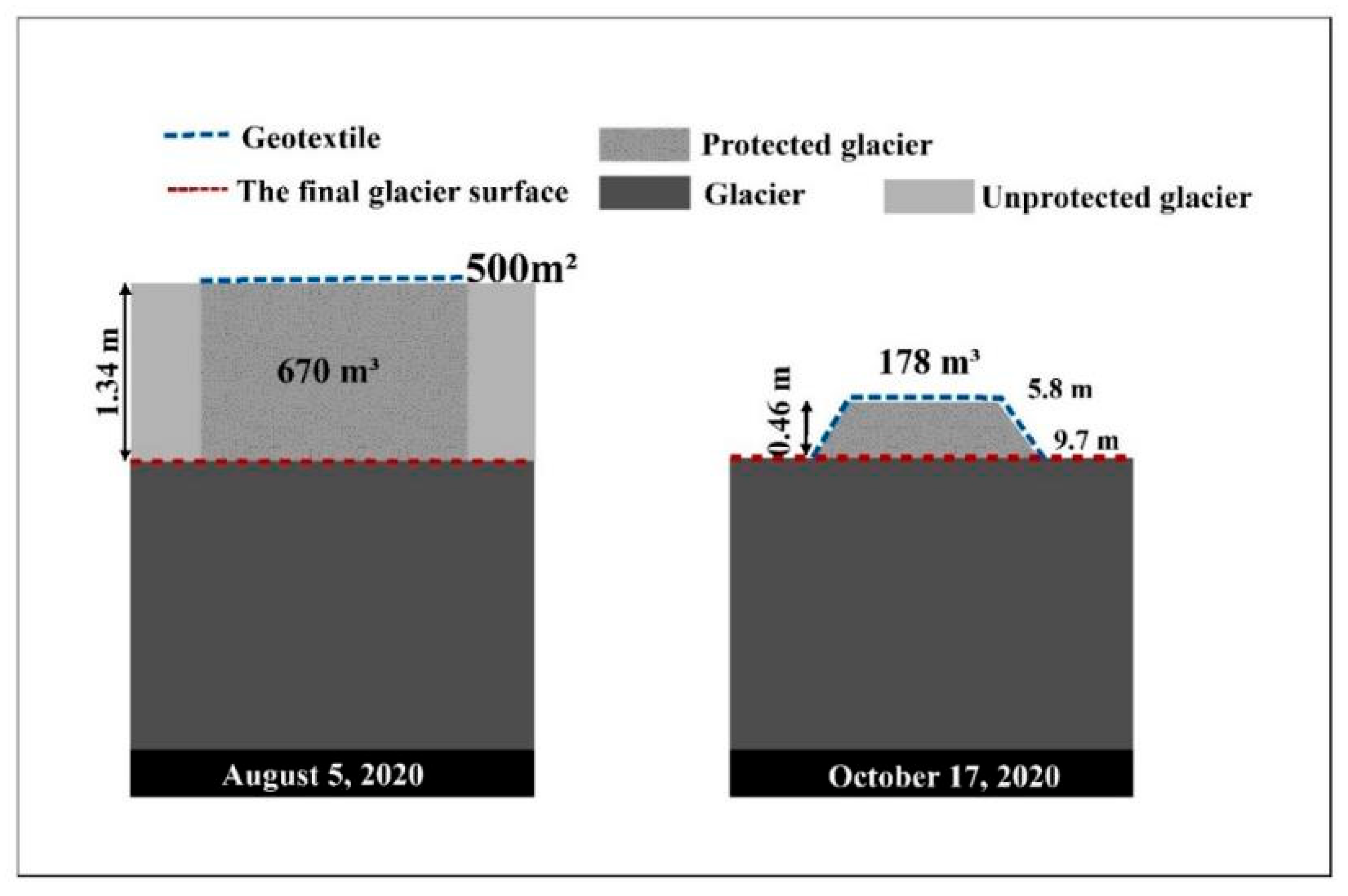
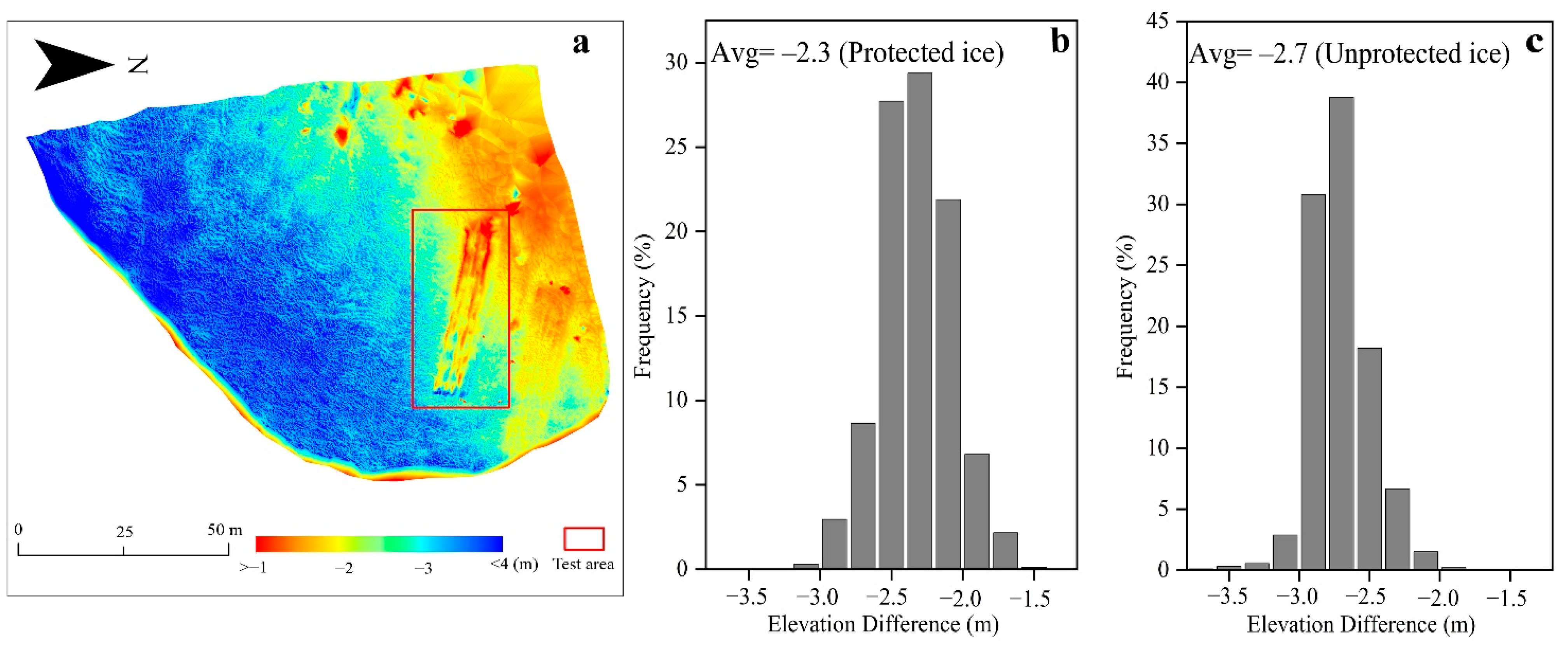
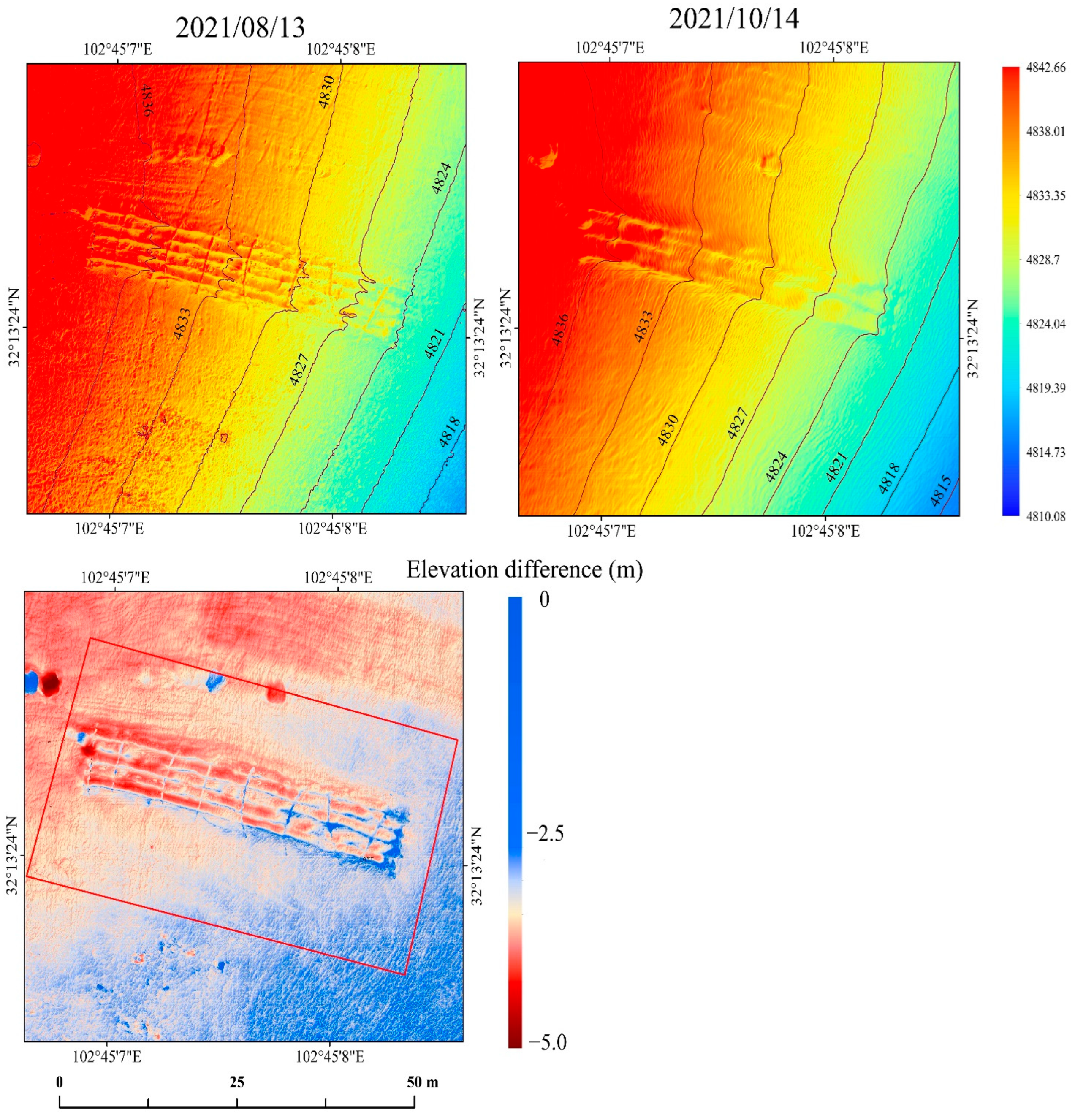
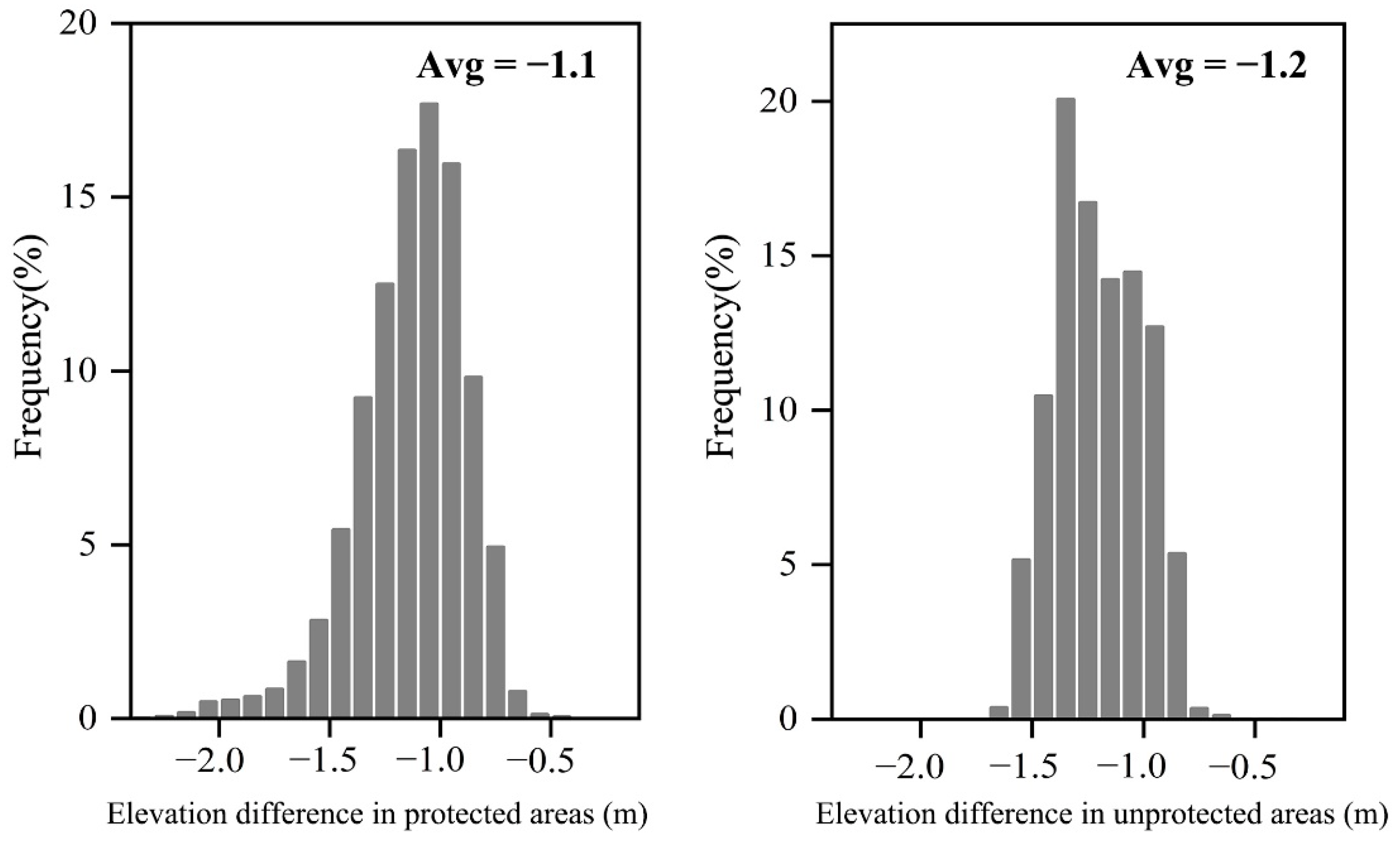
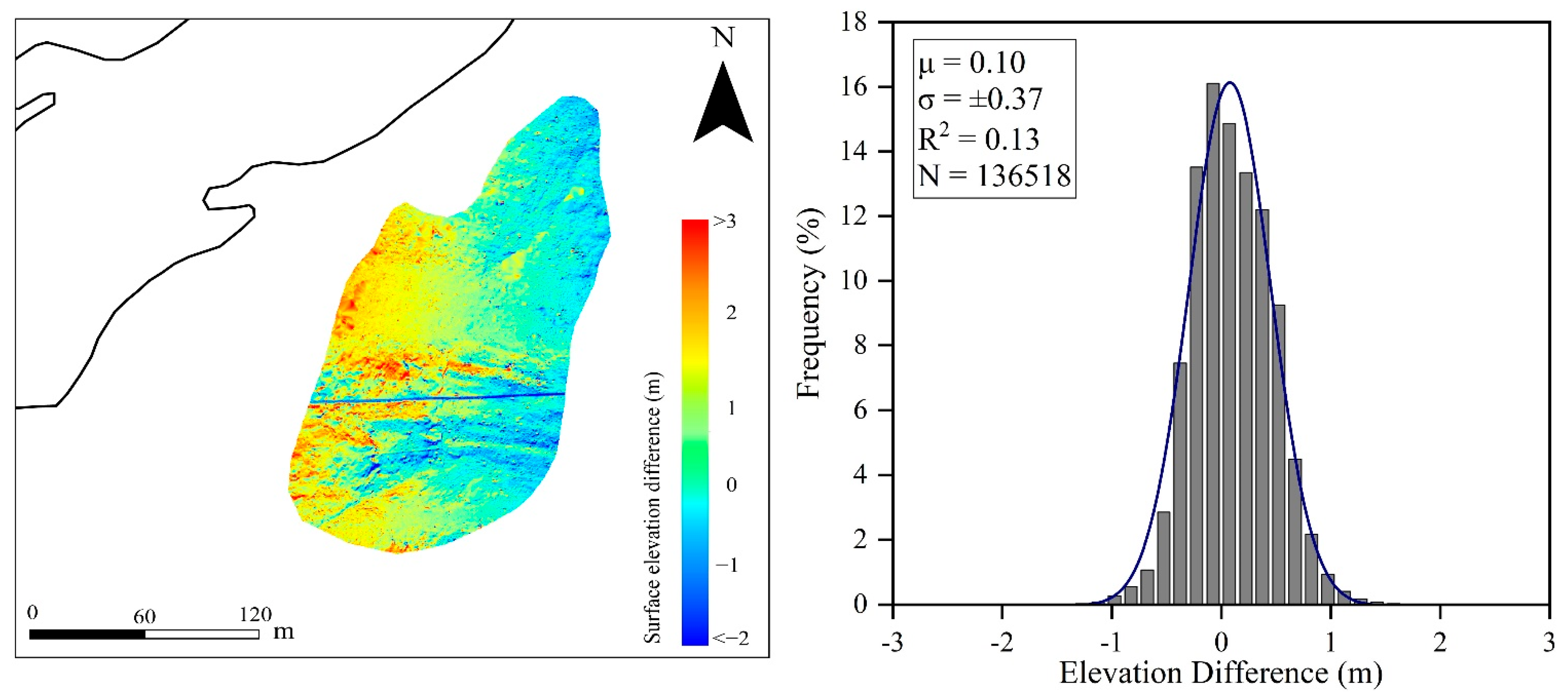
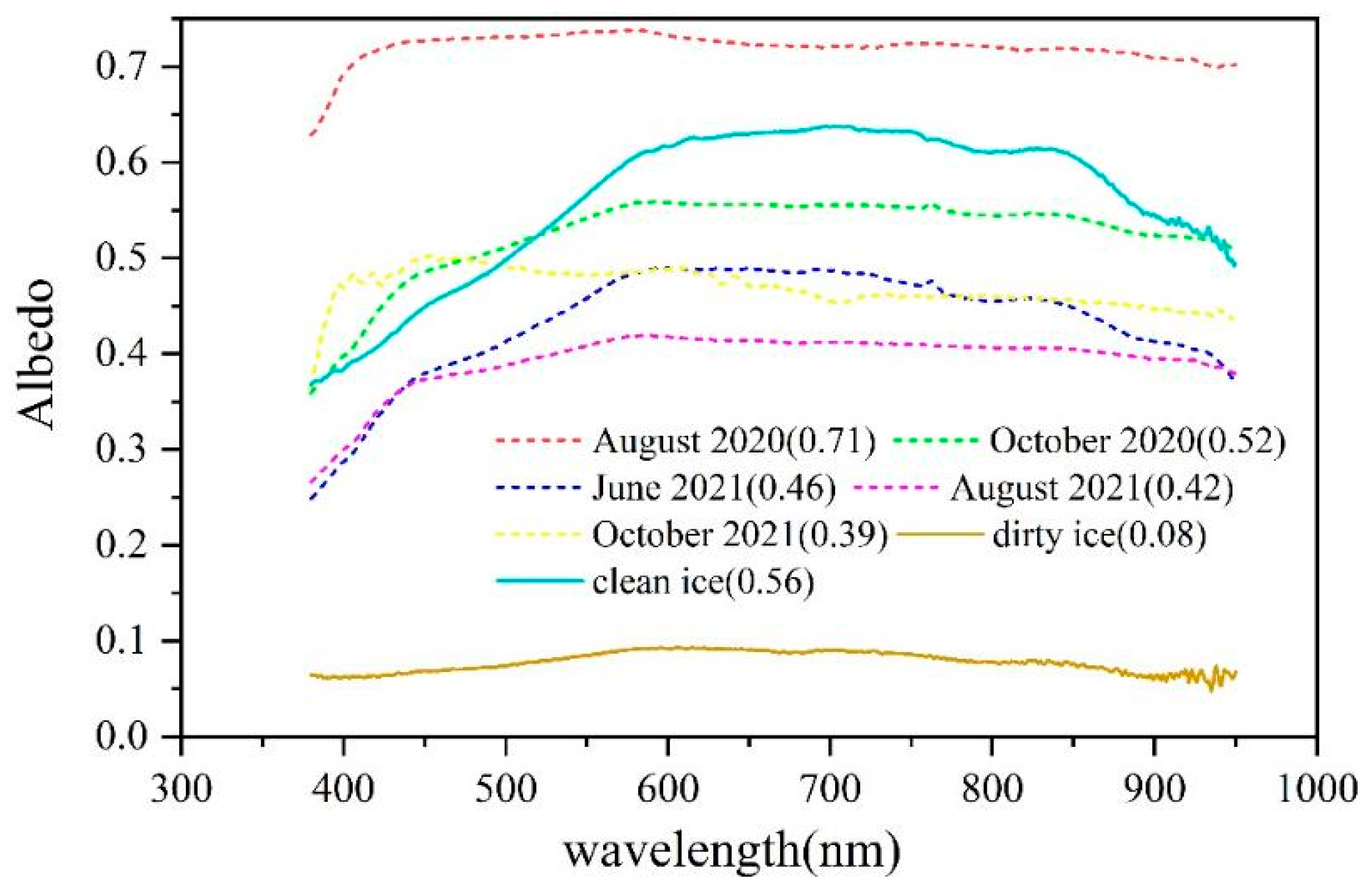
| Date | Scanning Range (m2) | Number of Points | Point Density (m−2) | Angle Increment (°) | Numbers of Scans |
|---|---|---|---|---|---|
| 17 October 2020 | 2,140,657 | 9,013,790 | 4.21 | 0.02 | 1 |
| 14 October 2021 | 1,997,944 | 7,893,198 | 3.95 | 0.02 | 1 |
| Date | 13 August 2021 | 14 October 2021 |
|---|---|---|
| Coverage (km2) | 0.009 | 0.122 |
| Flight altitude (m) | 100 | 200 |
| Resolution of orthomosaic/DSM (cm) | 0.8 | 2.5 |
| Number of photos taken/valid photos | 257/263 | 370/397 |
| Number of checkpoints used | 5 | 6 |
| RMSE Z error (m) | 0.02 | 0.06 |
| Errors between GNSS and DEM elevations in vertical direction (m) | 0.07 | 0.11 |
| Glacier (Country) | Tested Period |
Latitude (N) |
Longitude (E) |
Altitude (m a.s.l.) |
Area (m2) | εice/εsnow |
£ (%) | Source |
|---|---|---|---|---|---|---|---|---|
| Dosdè Est (Italy) | 15 May 2008–4 October 2008 | 46°23′ | 10°13′ | 2800 | 150 | εsnow, εice | 69 | [45] |
| Presena Ovest (Italy) | 15 May 2008–4 October 2008 | 46°13′ | 10°34′ | 2765 | 600 | εsnow, εice | 49 | [14] |
| Mount Aragatz (Armenia) | 29 June 2012–22 June 2013 | 40°28′ | 40°28′ | 3200 | 20,000 | εsnow, εice | 57 | [15] |
| DaGu No.17 (China) | 5 August 2020–17 October 2020 | 32°13′ | 102°45′ | 4830 | 500 | εice | 27 | This paper |
| DaGu No.17 (China) | 17 October 2020–14 October 2021 | 32°13′ | 102°45′ | 4830 | 500 | εice | 15 | This paper |
Disclaimer/Publisher’s Note: The statements, opinions and data contained in all publications are solely those of the individual author(s) and contributor(s) and not of MDPI and/or the editor(s). MDPI and/or the editor(s) disclaim responsibility for any injury to people or property resulting from any ideas, methods, instructions or products referred to in the content. |
© 2023 by the authors. Licensee MDPI, Basel, Switzerland. This article is an open access article distributed under the terms and conditions of the Creative Commons Attribution (CC BY) license (https://creativecommons.org/licenses/by/4.0/).
Share and Cite
Xie, Y.; Wang, F.; Xu, C.; Yue, X.; Yang, S. Applying Artificial Cover to Reduce Melting in Dagu Glacier in the Eastern Qinghai-Tibetan Plateau. Remote Sens. 2023, 15, 1755. https://doi.org/10.3390/rs15071755
Xie Y, Wang F, Xu C, Yue X, Yang S. Applying Artificial Cover to Reduce Melting in Dagu Glacier in the Eastern Qinghai-Tibetan Plateau. Remote Sensing. 2023; 15(7):1755. https://doi.org/10.3390/rs15071755
Chicago/Turabian StyleXie, Yida, Feiteng Wang, Chunhai Xu, Xiaoying Yue, and Shujing Yang. 2023. "Applying Artificial Cover to Reduce Melting in Dagu Glacier in the Eastern Qinghai-Tibetan Plateau" Remote Sensing 15, no. 7: 1755. https://doi.org/10.3390/rs15071755
APA StyleXie, Y., Wang, F., Xu, C., Yue, X., & Yang, S. (2023). Applying Artificial Cover to Reduce Melting in Dagu Glacier in the Eastern Qinghai-Tibetan Plateau. Remote Sensing, 15(7), 1755. https://doi.org/10.3390/rs15071755







